A PLACE FOR SHARING YOUR PRECIOUS LETTERS AND ARTICLES ON FR. BEDE GRIFFITHS
The monk & mystic Bede Griffiths experienced his "death of the mind" end of January 1990. A few weeks later he wrote me a long letter to share with us his wonderful insights of "overwhelming unconditional love" . At the age of 84 he planned to travel again to Europe, America and Australia to communicate his message of "beyond duality & darkness". The unique film was produced in October 1991 during Bede Griffiths' stay in Kreuth/Bavaria/Germany - the place he visited 5 times between September 1990 and October 1992. Kreuth was the birthplace for his spiritual legacy "UNIVERSAL WISDOM". Bede Griffiths avoided to speak of a personal GOD and preferred the term of "inner source of eternal being". In this fascinating short film he emphasizes that Jesus Christ had to give up his image of God before entering into eternity. Bede Griffiths made a clear distinction between body, soul & spirit. Body and soul (psyche) will ultimately pass away - the spirit will remain forever. This is the message of a giant in the history of spirituality.
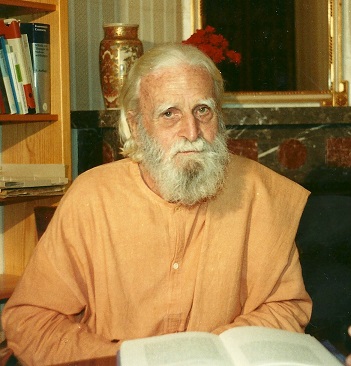
October 1991 - Bede Griffiths, Fr. Christudas & Benedikt (20 months)
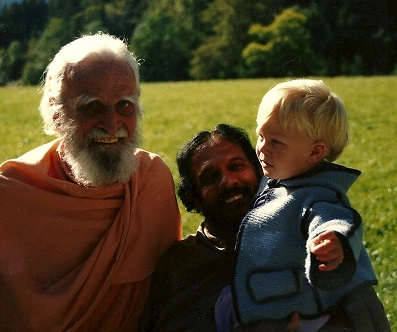
ROLAND ROPERS SHARED THE FOLLOWING:-
24th April 1991 - today 28 years ago - Sat-Chit-Ananda Ashram Shantivanam, Tannirpalli/Tamil Nadu
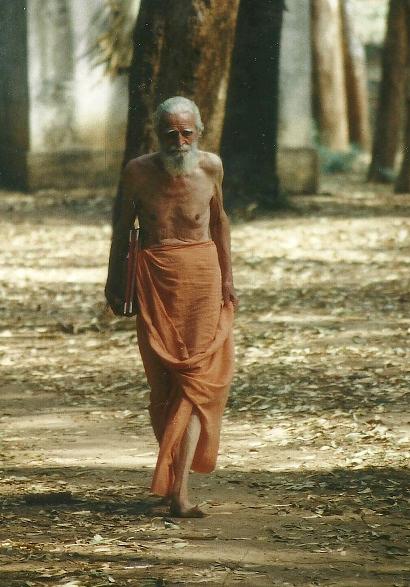
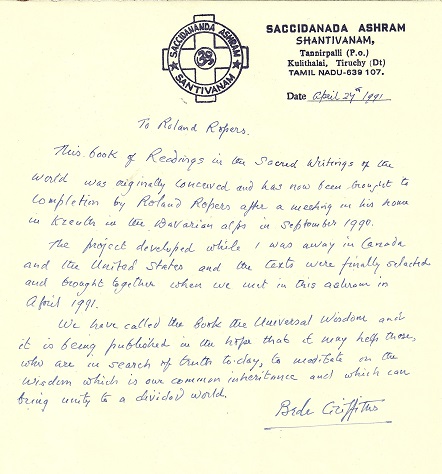
Sprach- & Kulturphilosoph
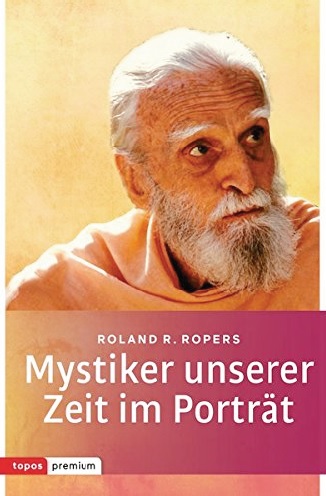
BEDE GRIFFITHS & MEISTER ECKHART - a unique document from 1st April 1992 --
HAPPY CHRISTMAS 2016!!!
from Roland Ropers
We need to remember that Meister Eckhart influenced and enriched the German language well before Martin Luther. Words like “Gelassenheit” and “Wirklich-keit” had been created by Meister Eckhart. The meaning of „Wirklichkeit“ is very important today; the English word „reality“ relates to Latin „res“ (thing, object), hoewever „Wirklichkeit“ has no object at all. It is the pure essence of the permanent change of being.
„Meister Eckhart was able to lead the church beyond the conceptual understanding of a personal God to a mystical experience in which the Godhead itself is encountered in its infinite, transcendent reality"
2 weeks after Bede Griffiths wrote his unique thoughts on Meister Eckhart we visited in London the Benedictine monk and Cardinal Basil Hume (1923 - 1999). On my personal request Basil Hume confirmed in wiriting that his fellow-brother was a living mystic. That was at time unique in the long history of the Church.
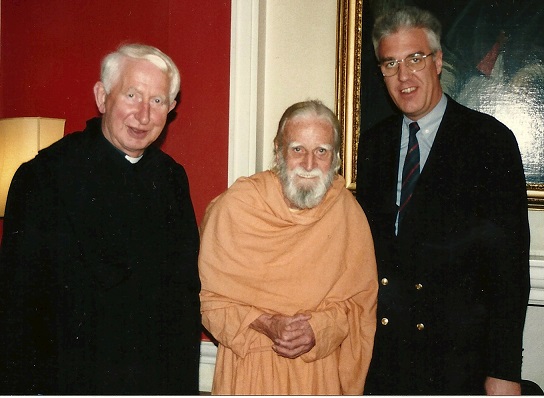
Cardinal Basil Hume Fr. Bede Griffiths and Roland Ropers
DIVINE REALITY BEYOND A PERSONAL GOD - CONTRIBUTED BY ROLAND ROPERS
PLEASE CLICK ON PDF. BELOW

|
GRIFFITS Meister Eckhart September 2011.pdf Size : 5151.261 Kb Type : pdf |
ROLAND R.ROPERS
RELIGIONS PHILOSOPH & PUBLIZIST
ETYMOSOPHIESPIRITUELLE SPRACHFORSCHUNG
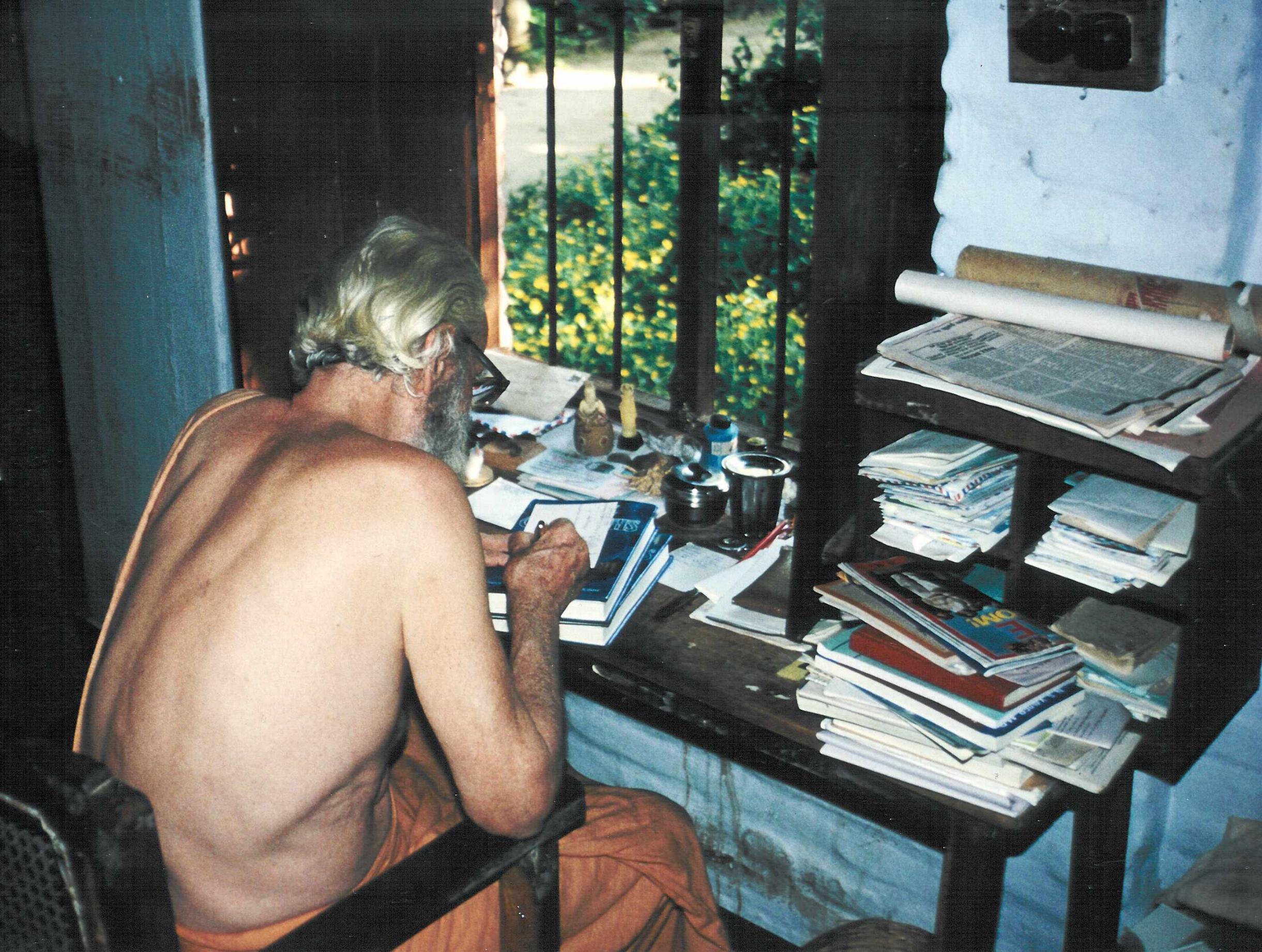
ONE with the Energies of Life
Bede Griffiths (1906-1993), the Benedictine monk and sage was convinced that the practice and knowledge of Dzogchen is the direct gateway to realize Supreme Reality. In 1992 Bede Griffiths introduced me in the innermost essence of that secret teaching and gave me one of his last handwritten manuscripts on 4thDecember 1992. This document is so precious and concise that it evidences the deepest source of a great spiritual master of the 20thcentury.
ALTE MÜNCHNER STRASSE 12
D82407WILZHOFEN /GERMANY
PHONE:+49(0)8811407165-FAX:+49(0)8811407170 MOBILE:+49(0)17645536139
E-MAIL:ROPARADISE@GMX.DE
The DZOGCHEN
(The main teaching of the Nying- ma- school of Tibetan Buddhism,
regarded as the ultimate and most secret teaching of Shakyamuni Buddha)by Bede Griffiths
Dzogchen, which means the great perfection (Dzog = perfection, chen = great) is a way of realization, a way of experience the fullness of wisdom and compassion. The tradition of the Dzogchen was brought to Tibet in the 8th century by Padmasambhava and Vimalamitra and put into a uniform system by Longchenpa in the 14th century. Normally, there are three stages of training required to achieve the great perfection. The first being meditation or sutra, wherein you follow the teaching of the Buddha. You start with the doctrine and discipline of the Buddha. You also meditate, do yoga, perform rituals and are initiated into the various stages of Spiritual Life. Then comes the tantra, the second stage. Unlike the sutra stage where you tend to leave the world behind and concentrate on the inner world; in the inner self, here in the tantra stage you start with the body, with the breath, with the blood, and with the feelings. It is the opposite of the sutra. With the sutra you leave everything behind. You forget your body, forget your feelings and focus on your mind, opening to the transcendent. At the tantra level, you start with the body, the senses, the feelings and the breath the breath particularly. In tantra, you begin to draw on the powers of the unconscious.
Christians, generally speaking, are completely ignorant of these powers of the unconscious.
Our religion is on the conscious level which we have developed quite marvelously. But beyond the conscious are all these powers of the unconscious where we are one with nature, with the dynamic forces in the unconscious which are tremendously powerful but which can be controlled, and you can learn to control them, in nature and in your own being.
The third stage is where you go beyond meditation and beyond the tantra and discern what is known as the Primordial State, the Buddha nature within you. In Christian terms we would say: you have your body, your physical organism and you have learnt to control a great deal of that energy; you have 3 your psychological organism: senses, feeling, imagination, reason, will andthen you go beyond your body, beyond your psyche to your pneuma, your spirit, the atman in Sanskrit, and there you open up to the Divine, the Transcendent, the Infinite. The aim of all this practice is to open up to the sphere of the Infinite and the Eternal, which is in everybody and everything.
GOD is in everybody and everything but is hidden.
We live in our bodies and we forget about the spirit. We live in our psyches and we are occupied by that.
And we Christians, most of us, have not discovered the spirit yet.
Most of our religion is on the level of the body and the psyche; it is all in our mind, our will, our conscious mind which is good as far as it goes. But beyond the body and the psyche is the pneuma, the spirit. St. Francis of Sales called it: ,,the fine point of the soul", the point which the great Jesuit and theologian Karl Rahner mentions as the point of self- transcendence. We have within us the capacity to transcend the body and the soul and to open onto the Divine, the infinite and the eternal. It is in every human being, it is what is called Buddha nature. It is, of course, hidden. It is the ground as it were. But all the work of meditation and of the tantra is intended to open up this hidden centre where we are one with the Supreme, the Eternal.
The teaching of Dzogchen is that you don`t have to go through all the discipline: you don`t have to do tantra.
You can get a sudden enlightment and it is normally by transmission.
This is like the Hindu tradition. In the Hindu tradition the Guru is one who has had experience of Brahman, the Infinite. He is able to transmit it to another who eventually opens up and becomes enlightened. The person then may have sudden enlightment: a total oneness with the Supreme brahmavidya - realization of the Atman, realization of your own inner self. Through this you discover the Infinite, the Eternal. In the Buddhist tradition you discover your Buddha nature. You enter into Buddhahood. In India we talk about jivanmukta: the person liberated while still alive. Dzogchen speaks of the ultimate state as the Primordial State, existing from the beginning, hidden beyond your body, senses, your feelings and all your limitations.
In the Dzogchen teaching you realize your Buddha nature, the Primordial State, and that state is absolute perfection. In that state everything is contained in perfect wholeness, fullness, bliss. In the Hindu tradition we speak of Saccidananda: being in full consciousness and absolute bliss. That is the goal for all Hindus.
In the Dzogchen, they say the master can initiate you into this experience of the Primordial State. In this state you do not leave the world behind. I believe that the danger with the meditation movement is that you tend toleave the world behind. You concentrate on your mind, you go beyond, but the world is lost. You do not know how to relate to it. You tend to think of it all as an illusion, and that is very dangerous: it is a sort of dualism. In the Dzogchen and the deeper traditions of Buddhism and Hinduism you have to integrate all the other levels of reality in the Supreme. The physical, the psyche, with all aspects have to be integrated in the supreme wisdom. This is jnana the root jna being the same as the English know the divine knowledge. In India we speek of jnana, in Buddhism of prajna and in Greek of gnosis, the Divine Knowledge. You share the divine knowledge and you have the experience of the Infinite Transcendent One.
Dzogchen says that when you have reached that state you have integrated your whole being, the being of nature around you, the being of your body, of your psyche and all its capacities. They are all gathered into unity in the one Supreme Reality. And that is the goal of Dzogchen: to reach that total oneness. This is extremely close to the Christian idea of pleroma as found in St. Paul`s epistles that means fullness. The idea is that Christ is the Pleroma of God. The fullness of the Divine was present in Christ. ,,In him dwelt the fullness ofthe Godhead bodily." So for us Christians, Christ is the one in whom the fullness of Divine Reality is totally present. Later on it says: ,He is the first-born from the dead and the Church is the fullness of Christ." So, from the Father, the source, the fullness comes to Christ and from Christ the fullness goes to the Church, to us and to the disciples. And so we experience his fullness. It seems to me that we now see that the Hindu, the Buddhist, the Muslim and the Christian are all seeking to experience this fullness, this pleroma of reality, which in every doctrine is both wisdom and love. They are the two characteristics.
In our Christian tradition we say the Father is the source, the origin, the one beyond. We cannot name the Father properly: It is only a name for that which is beyond all name and form.
In the Tibetan tradition, in that primordial state all is totally one; everything is gathered into unity and then manifests itself in the universe. The universe comes out from its primordial state in all its multiplicity. The earth, the sky, the trees, people.
We are all manifestations of the supreme wisdom which is reflected as in a mirror. The universe is like a mirror which reflects the primordial state; primordial reality. We all reflect it in our limited way.But we can grow in understanding until we become fully mirrors.
Jesus, we say, is the image of the invisible God, the total reality. Since we are all made in the image of God, we can discover this image within ourselves of this one reality. In Dzogchen we realize it suddenly. In others you approach it gradually through meditation, study, yoga and discipline.
But we must not forget the discipline of love.
It is not only sitting and meditation: Karuna, compassion is one of the essential ways to realize God. You realize the fullness, the wholeness and the non- duality. This is a very important concept that is just coming into our theology today: that the ultimate reality is not one and not two. This is the problem with God. In our Christian tradition we think of God as a person the Heavenly Father. It is always some person and we project an image of it, and we worship that image as God. But we know that no image and no concept is adequate.
We have to go beyond our images.
We have to leave our images, of Jesus etc.. We have to leave our concepts of the Trinity, the Incarnation, because the reality is always beyond our images, all our thoughts. We are always moving towards the infinite transcendent, the Holy One, and that will be the end of life. And so the Divine mystery is revealing itself in creation, revealing itself in humanity, and comes to head for the Christian in Christ. Christ is the head of the body of the church; the head of all creation and then He goes beyond and takes the whole of creation, of humanity back to its source in the Godhead.
There is one aspect of Dzogchen which has a very close analogy in Christianity.
In Dzogchen the Primordial State, the Supreme Reality, is realized suddenly without the preparation of meditation or yoga. In the Christian tradition also contemplation is a gift of God. It is not something which we can acquire by meditation or a personal effort. It is a pure grace. It comes to those who are ready to receive it, not as something acquired by human effort but as a gift of grace. It is God`s action in us, not our own action. In the Buddhist and in the Hindu tradition this may come as a gift of the Guru, who awakens the disciple to his presence. For the Christian it comes as a gift of the Holy Spirit given by Christ as the sat- guru, the supreme teacher who communicates his own inner life to his disciples.
Bede Griffiths O.S.B.
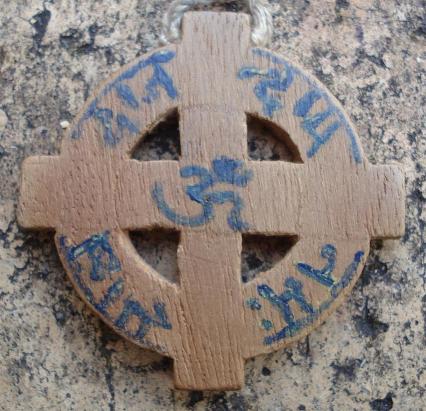
COSMIC CROSS OF SACCIDANANDA ASHRAM SHANTIVANAM -
OM (IN THE CENTRE) SACCIDANANDAYA NAMAHA
THE COSMIC CROSS – THIS IS A WOODEN CROSS ENCLOSED IN A CIRCLE OR CHAKRA. THE CHAKRA REPRESENTS THE COSMIC MYSTERY, THE WHEEL OF THE LAW (DHARMA CHAKRA), AND ROUND IT ARE INSERTED THE WORDS ’SACCIDANANDAYA NAMAH’ IN SANSKRIT LETTERS (WORSHIP TO SACCIDANANDA, THE GODHEAD). AT THE CENTRE OF THE CROSS IS THE WORD OM, AGAIN IN SANSKRIT, SIGNIFYING THE WORD OF GOD AS SOURCE OF CREATION AND OF REDEMPTION IN CHRIST. Bede Griffiths
A ROUGH SKETCH BY STEPHEN DAY